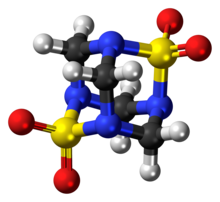
| |

| |
| Names | |
|---|---|
| Preferred IUPAC name
2λ6,6λ6-Dithia-1,3,5,7-tetraazaadamantane-2,2,6,6-tetrone | |
| Other names
Tetramine, TETS, DSTA, Dushuqiang, Four-two-four, 424, NSC 172824, Meishuming, Sanbudao
| |
| Identifiers | |
3D model (JSmol)
|
|
| Abbreviations | TETS, DSTA |
| ChemSpider | |
| ECHA InfoCard | 100.231.255 |
PubChem CID
|
|
| UNII | |
CompTox Dashboard (EPA)
|
|
| |
| |
| Properties | |
| C4H8N4O4S2 | |
| Molar mass | 240.26 g/mol |
| Appearance | White powder |
| Melting point | 255 to 260 °C (491 to 500 °F; 528 to 533 K) |
| 0.25 mg/mL | |
| Hazards | |
| Occupational safety and health (OHS/OSH): | |
Main hazards
|
extremely toxic |
| GHS labelling: | |

| |
| Lethal dose or concentration (LD, LC): | |
LD50 (median dose)
|
0.90 mg/kg (mice) |
Except where otherwise noted, data are given for materials in their standard state (at 25 °C [77 °F], 100 kPa).
| |
Tetramethylenedisulfotetramine (TETS) is an organic compound used as a rodenticide (rat poison).[2] It is an odorless, tasteless white powder that is slightly soluble in water, DMSO and acetone, and insoluble in methanol and ethanol. It is a sulfamide derivative. It can be synthesized by reacting sulfamide with formaldehyde solution in acidified water.[3] When crystallized from acetone, it forms cubic crystals with a melting point of 255–260 °C.
- ^ Merck Index, 11th Edition, 9158.
- ^ "Basic datasheet for tetramethylene disulfotetramine". Inchem.
- ^ Zhao, C; Hwang, S. H; Buchholz, B. A; Carpenter, T. S; Lightstone, F. C; Yang, J; Hammock, B. D; Casida, J. E (2014). "GABAA receptor target of tetramethylenedisulfotetramine". Proceedings of the National Academy of Sciences of the United States of America. 111 (23): 8607–12. Bibcode:2014PNAS..111.8607Z. doi:10.1073/pnas.1407379111. PMC 4060666. PMID 24912155.